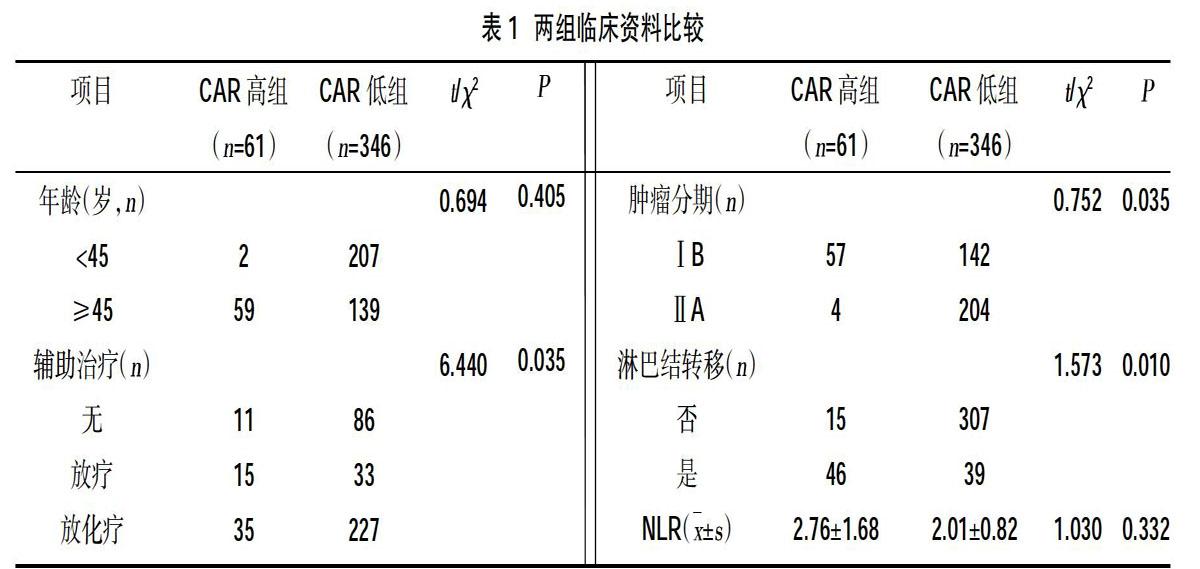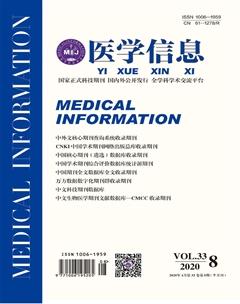CAR与宫颈癌患者预后的关系
苏叶舟 徐祖滢 向卉芬 魏兆莲 曹云霞



摘要:目的 探討C反应蛋白与白蛋白之比(CAR)与宫颈癌患者淋巴结转移和预后的关系。方法 回顾性分析2008年1月~2013年1月安徽医科大学第一附属医院收治的407例行宫颈癌根治术ⅠB~ⅡA期宫颈癌患者患者的临床病理资料,根据CAR临界值分为CAR高组及CAR低组,比较两组临床资料,并采用Cox单因素和多因素分析宫颈癌患者预后的相关因素,采用Kaplan-Meier法分析两组生存率。结果 ROC曲线分析显示,CAR截值为0.15,ROC曲线下的面积分别为0.709,CAR随访时间、敏感度、特异度分别为5年,0.756,0.894。两组年龄、肿瘤大小、病理类型比较,差异无统计学意义(P>0.05);两组辅助治疗、肿瘤分期、淋巴结是否转移比较,差异有统计学意义(P<0.05)。Cox单因素分析显示,宫颈癌患者的预后与肿瘤分期、辅助治疗、淋巴结转移、NLR、PLR、PNI、CAR相关(P<0.05);Cox多因素分析显示,肿瘤分期、辅助治疗和CAR是影响宫颈癌患者预后的独立因素(P<0.05)。Kaplan-Meier生存曲线显示,CAR高组生存率低于CAR低组,差异有统计学意义(P<0.05)。结论CAR值是影响宫颈癌患者预后的独立因素,其预测价值较好。
关键词:C反应蛋白与白蛋白之比;宫颈癌;预后因子
中图分类号:R737.33 文献标识码:A DOI:10.3969/j.issn.1006-1959.2020.08.026
文章编号:1006-1959(2020)08-0080-04
Abstract:Objective To explore the relationship between the ratio of C-reactive protein to albumin (CAR) and lymph node metastasis and prognosis in patients with cervical cancer.Methods A retrospective analysis of the clinicopathological data of 407 patients with cervical cancer stage ⅠB ~ ⅡA who were admitted to the First Affiliated Hospital of Anhui Medical University from January 2008 to January 2013 was divided into CAR high groups according to the CAR threshold compared with the CAR low group, the clinical data of the two groups were compared. Cox univariate and multivariate were used to analyze the prognostic factors of cervical cancer patients. The Kaplan-Meier method was used to analyze the survival rates of the two groups.Results ROC curve analysis showed that the CAR cut-off value was 0.15, the area under the ROC curve was 0.709, and the CAR follow-up time, sensitivity, and specificity were 5 years, 0.756, and 0.894, respectively. There was no statistically significant difference in age, tumor size, and pathological type between the two groups (P>0.05); there were statistically significant differences in adjuvant therapy, tumor stage, and lymph node metastasis between the two groups (P<0.05). Cox single factor analysis showed that the prognosis of cervical cancer patients was related to tumor staging, adjuvant therapy, lymph node metastasis, NLR, PLR, PNI, CAR (P<0.05); Cox multivariate analysis showed that tumor staging, adjuvant therapy, and CAR independent factors for the prognosis of cervical cancer patients (P<0.05). The Kaplan-Meier survival curve showed that the survival rate of the high CAR group was lower than that of the low CAR group,the difference was statistically significant (P<0.05).Conclusion CAR value is an independent factor affecting the prognosis of cervical cancer patients, and its predictive value is good.
Key words:Ratio of C-reactive protein to albumin;Cervical cancer;Prognostic factor
宫颈癌(cervical cancer)是女性最常见的恶性肿瘤之一,致死率较高[1],其中80%的宫颈癌病理类型是磷状细胞癌,对于ⅠB~ⅡA期的宫颈癌患者,根治性子宫切除术后辅助化疗或者放化疗是目前较为有效的治疗措施,但一旦宫颈癌患者术后出现肿瘤复发,预后较差[2]。宫颈癌淋巴转移是影响宫颈癌患者复发和轉移的重要影响因素,临床上对于宫颈癌患者淋巴结转移的诊断主要是通过影像学手段和病理活检,其操作困难、有创,因此发现合适和较高敏感性的宫颈癌标志物对于判断淋巴结转移尤为重要,对于预测宫颈癌患者的预后具有一定的帮助并且可提供一定的临床理论指导。
不同的癌症相关介质可以促进肿瘤的生长、侵犯、转移和血管生成,人乳头状瘤病毒HPV可以通过引发炎症反应促进宫颈癌的生长[3]。相关研究表明[5],提高患者的营养状况可以改善患者的炎症反应[4]。临床实验证明,营养不良和低白蛋白血症是恶性肿瘤炎症过度反应的的结局,其中白蛋白是早期宫颈癌患者预后的独立影响因素[6],一些炎症标志物包括血小板淋巴细胞比(platelet-to-lymphocyte ratio,PLR),中性淋巴细胞比(neutrophil-to-lymphocyte ratio,NLR)和预后营养因子(prognostic nutritional index,PNI)在许多恶性肿瘤中已经被证明是较好的预后因子[7-10]。血液当中能够反映炎症情况最直接的指标是C反应蛋白,C反应蛋白与白蛋白之比(the CRP/albumin ratio,CAR)近年来被证实是肝癌、肺癌、结肠癌、食管癌和胰腺癌等[11-15]多种恶性肿瘤的独立预后指标。目前关于CAR的预测价值与宫颈癌关系的研究很少,本研究旨在探讨C反应蛋白与CAR与宫颈癌患者淋巴结转移和预后的关系,现报道如下。
1资料与方法
1.1一般资料 收集2009年1月~2013年4月安徽医科大学大学第一附属医院收治的407位行宫颈癌根治术的ⅠB~ⅡA期宫颈癌患者的临床资料。纳入标准:①均经病理检查证实为宫颈癌;②均行根治术子宫切除加盆腔淋巴结清扫;③血液标本于手术前1周内获得。排除标准:①术前已行新辅助放化疗者;②有同时或异时的多原发性肿瘤者;③伴随其他较严重的疾病可能影响外周血细胞的数值疾病者;④出现恶病质、大出血等严重并发症者。
1.2方法
1.2.1资料收集 收集患者的临床资料,包括性别、年龄、辅助治疗、肿瘤大小、肿瘤分期、淋巴结转移、病理类型及血常规和生化结果。NLR、PLR、PNI及CAR比值计算方法:①NLR=中性粒细胞/淋巴细胞;②PLR=血小板/淋巴细胞;③PNI=血清白蛋白值(g/L)+5×外周血淋巴细胞总数(×109/L);④CAR=C反应蛋白/白蛋白。
1.2.2确定CAR界值 绘制AAR受试者工作特征(ROC)曲线,采用约登指数确定界值,约登指数=灵敏度-(1-特异度)。根据CAR临界值分为CAR高组及CAR低组。
1.2.3随访方式 术后患者根据淋巴结转移情况和术后病理确定放化疗治疗,终点事件定义为因宫颈癌发生的死亡事件,总体生存期时间(OS)是从手术当天到随访截止日期或者终点事件发生时,所有的宫颈癌患者术后前两年内每3个月随访一次,随后每6个月随访一次,直到2018年4月或者死亡。
1.3统计学分析 应用SPSS 22.0统计软件进行数据分析。计数资料以(n)和(%)表示,采用?字2检验;计量资料以(x±s)表示,采用t检验;采用ROC曲线分析CAR界值,采用Cox回归模型进行单因素和多因素分析,采用Kaplan-Meier法绘制生存曲线。以P<0.05表示差异有统计学意义
2结果
2.1 ROC曲线分析CAR界值 CAR截值为0.15,ROC曲线下的面积分别为0.709,见图1;其中CAR随访时间、敏感度、特异度分别为5年,0.756,0.894。
2.2两组临床资料比较 根据CAR界值分为CAR高组(≥0.15)61例及CAR低组(<0.15)346例。两组年龄、肿瘤大小、病理类型比较,差异无统计学意义(P>0.05);两组辅助治疗、肿瘤分期、淋巴结是否转移比较,差异有统计学意义(P<0.05),见表1。
2.3宫颈癌患者预后的Cox单因素和多因素分析 单因素分析显示,宫颈癌患者的预后与肿瘤分期、辅助治疗、淋巴结转移、NLR、PLR、PNI、CAR相关(P<0.05);多因素分析显示,肿瘤分期、辅助治疗和CAR是影响宫颈癌患者预后的独立因素(P<0.05),见表2。
2.4两组预后比较 随访至2018年4月,CAR高组发生56例(91.80%)终点事件,CAR低组发生25例(7.23%)终点事件;Kaplan-Meier生存曲线显示,CAR高组生存率为0.41%,低于CAR低组的0.64%,差异有统计学意义(?字2=6.724,P=0.001),见图2。
3讨论
在恶性肿瘤微环境中,癌症的发生发展与炎症反应密切相关。基因的改变可以引发炎症,同时炎症可以促进癌症的进展,血清标志物中的CRP、中性粒细胞,淋巴细胞、血小板、白蛋白及其衍生的很多炎症和营养相关标志物等在机体的免疫系统中扮演着重要的作用,这些标志物被称为预测因子,对判断肿瘤的进展可能有重要的价值。其中CAR是通过C反应蛋白和白蛋白计算得出,大量研究表明CAR对于判断肿瘤进展和患者预后有较大价值,但关于CAR与ⅠB~ⅡA期宫颈癌患者的预后报道较少。本研究主要探讨CAR指标对于判断宫颈癌患者淋巴结转移和患者预后的价值。
作為构成CAR的两个重要指标,其中CRP被报道是影响宫颈癌患者预后的独立影响因素[16,17]。有研究表明,CAR升高与肝癌[18]、肺癌[19,20]、胰腺癌[21]、卵巢癌[22]等多种不同类型癌症患者预后差相关。肿瘤产生的炎症微环境可以产生白介素6(IL-6),而IL-6可以引起CRP的升高[18]。研究表明[17],CRP升高与癌症患者的肿瘤坏死、组织损伤、炎症反应相关,CRP基因的多态性可以降低肿瘤患者的免疫防御功能。本研究根据CAR临界值分为CAR高组及CAR低组,ROC曲线分析CAR截值为0.15,ROC曲线下的面积分别为0.709,CAR随访时间、敏感度、特异度分别为5年,0.756,0.894。两组年龄、肿瘤大小、病理类型比较,差异无统计学意义(P>0.05);两组辅助治疗、肿瘤分期、淋巴结是否转移比较,差异有统计学意义(P<0.05)。Cox单因素分析显示,宫颈癌患者的预后与肿瘤分期、辅助治疗、淋巴结转移、NLR、PLR、PNI、CAR相关(P<0.05);Cox多因素分析显示,肿瘤分期、辅助治疗和CAR是影响宫颈癌患者预后的独立因素(P<0.05),表明CAR与其它炎症标志物相比,其预测价值和敏感性更高。CRP和白蛋白是临床上简便易得的指标,本研究将CAR应用扩展到评价宫颈癌患者预后,结果表明CAR具有良好的预测价值。Kaplan-Meier生存曲线显示,CAR高组生存率低于CAR低组,差异有统计学意义(P<0.05),说明CAR值较高的患者其预后较差,临床应针对CAR值较高的患者提前进行营养和免疫炎症等方面的治疗,以提高患者的生存质量和预后。
综上所述,CAR能反映宫颈癌的疾病状态和炎性反应,是影响宫颈癌患者预后的独立因素,具有较好的预测价值。
参考文献:
[1]Siegel RL,Miller KD,Jemal A.Cancer statistics,2018[J].Ca A Cancer Journal for Clinicians,2018,68(1):7.
[2]Niu C,Sun X,Zhang W,et al.NR2F6 Expression Correlates with Pelvic Lymph Node Metastasis and Poor Prognosis in Early-Stage Cervical Cancer[J].International Journal of Molecular Sciences,2016,17(10):1694.
[3]Deivendran S,Marzook KH,Radhakrishna Pillai M.The role of inflammation in cervical cancer[J].Adv Exp Med Biol,2014(816):377-399.
[4]Zhang L,Su Y,Chen Z,et al.The prognostic value of preoperative inflammation-based prognostic scores and nutritional status for overall survival in resected patients with nonmetastatic Siewert type Ⅱ/Ⅲ adenocarcinoma of esophagogastric junction[J].Medicine(Baltimore),2017,96(30):e7647.
[5]Nazha B,Moussaly E,Zaarour M,et al.Hypoalbuminemia in colorectal cancer prognosis:Nutritional marker or inflammatory surrogate[J].World J Gastrointest Surg,2015,7(12):370-377.
[6]Zheng RR,Huang M,Jin C,et al.Cervical cancer systemic inflammation score:a novel predictor of prognosis[J].Oncotarget,2016,7(12):15230-15242.
[7]Templeton AJ,Ace O,McNamara MG,et al.Prognostic role of platelet to lymphocyte ratio in solid tumors:a systematic review and meta-analysis[J].Cancer Epidemiol Biomarkers Prev,2014,23(7):1204-1212.
[8]Dolan RD,McSorley ST,Horgan PG,et al.The role of the systemic inflammatory response in predicting outcomes in patients with advanced inoperable cancer:Systematic review and meta-analysis[J].Crit Rev Oncol Hematol,2017(116):134-146.
[9]Haraga J,Nakamura K,Omichi C,et al.Pretreatment prognostic nutritional index is a significant predictor of prognosis in patients with cervical cancer treated with concurrent chemoradiotherapy[J].Molecular and Clinical Oncology,2016(5):567-574.
[10]Sun K,Chen S,Xu J,et al.The prognostic significance of the prognostic nutritional index in cancer:a systematic review and meta-analysis[J].Journal of Cancer Research and Clinical Oncology,2014,140(9):1537-1549.
[11]Kinoshita A,Onoda H,Imai N,et al.The C-Reactive Protein/Albumin Ratio,a Novel Inflammation-Based Prognostic Score,Predicts Outcomes in Patients with Hepatocellular Carcinoma[J].Annals of Surgical Oncology,2015,22(3):803-810.
[12]Zhou T,Zhan J,Hong S,et al.Ratio of C-Reactive Protein/Albumin is An Inflammatory Prognostic Score for Predicting Overall Survival of Patients with Small-cell Lung Cancer[J].Scientific Reports,2015(5):10481.
[13]Shibutani M,Maeda K,Nagahara H,et al.Prognostic Significance of the Preoperative Ratio of C-Reactive Protein to Albumin in Patients with Colorectal Cancer[J].Anticancer Research,2016,36(3):995-1002.
[14]Otowa Y,Nakamura T,Yamamoto M,et al.C-reactive protein to albumin ratio is a prognostic factor for patients with Stage /Ⅲ esophageal squamous cell cancer[J].Dis Esophagus,2017,30(12):1-5.
[15]Stevens L,Pathak S,Nunes QM,et al.Prognostic significance of pre-operative C-reactive protein and the neutrophil-lymphocyte ratio in resectable pancreatic cancer:a systematic review[J].HPB(Oxford),2015,17(4):285-291.
[16]Bodner-Adler B,Kimberger O,Schneidinger C,et al.Prognostic Significance of Pre-treatment Serum C-Reactive Protein Level in Patients with Adenocarcinoma of the Uterine Cervix[J].Anticancer Research,2016,36(9):4691-4696.
[17]Polterauer S,Grimm C,Zeillinger R,et al.Association of C-Reactive Protein(CRP)Gene Polymorphisms,Serum CRP Levels and Cervical Cancer Prognosis[J].Anticancer Research,2011,31(6):2259-2264.
[18]Kumar A,Jain M,Yadav A,et al.Pattern of mismatch repair protein loss and its clinicopathological correlation in colorectal cancer in North India[J].S Afr J Surg,2018,56(1):25-29.
[19]Zimmerman MA,Selzman CH,Cothren C,et al.Diagnostic implications of C-reactive protein[J].Arch Surg,2003,138(2):220-224.
[20]Friel G,Liu CS,Kolomeyevskaya NV,et al.Aspirin and Acetaminophen Use and the Risk of Cervical Cancer[J].Journal of Lower Genital Tract Disease,2015,19(3):189-193.
[21]Hindler K,Cleeland CS,Rivera E,et al.The role of statins in cancer therapy[J].Oncologist,2006,11(3):306-315.
[22]Trikha M,Corringham R,Klein B,et al.Targeted anti-interleukin-6 monoclonal antibody therapy for cancer:a review of the rationale and clinical evidence[J].Clin Cancer Res,2003,9(13):4653-4665.
收稿日期:2020-01-18;修回日期:2020-02-17
編辑/杜帆

